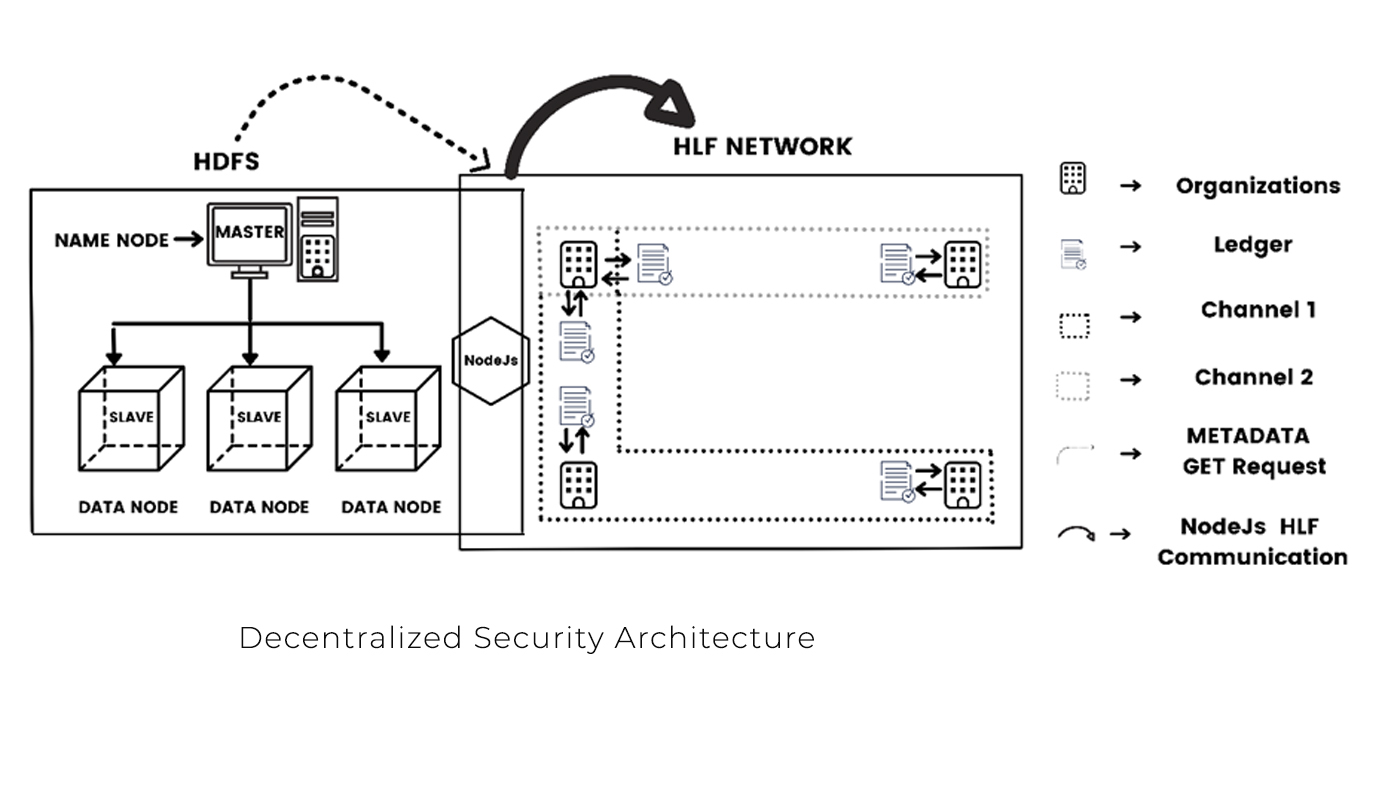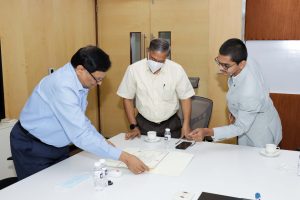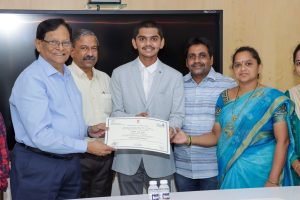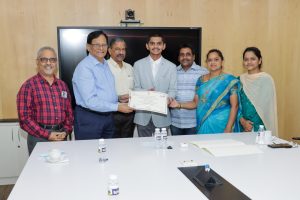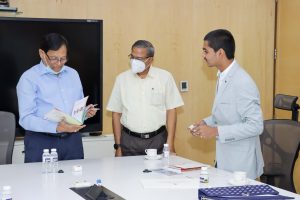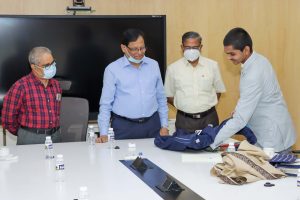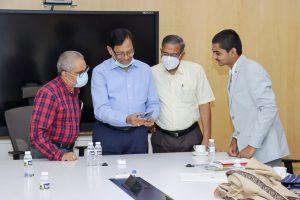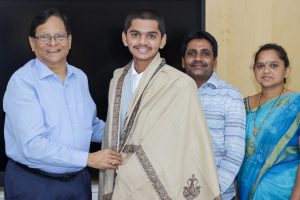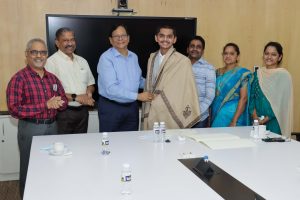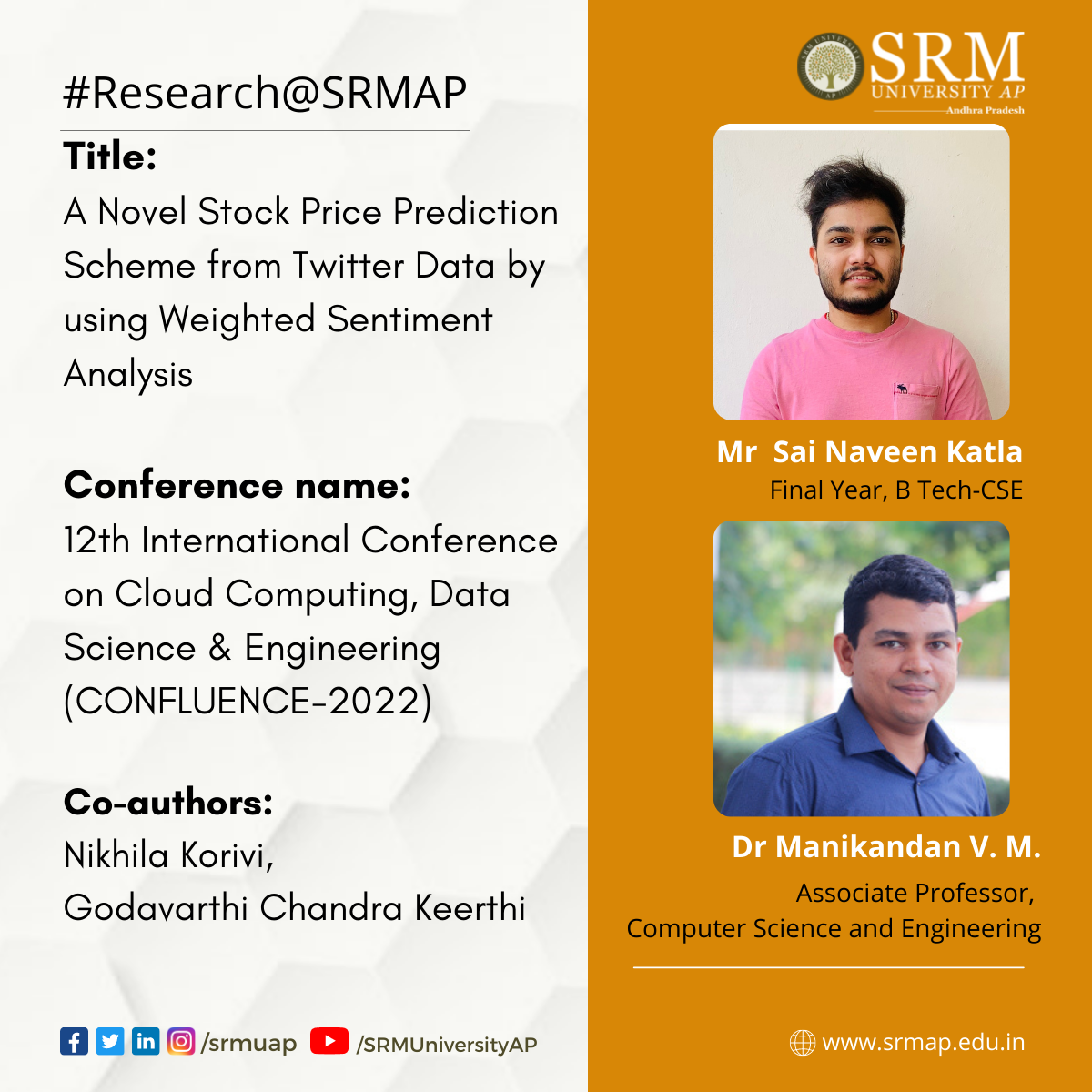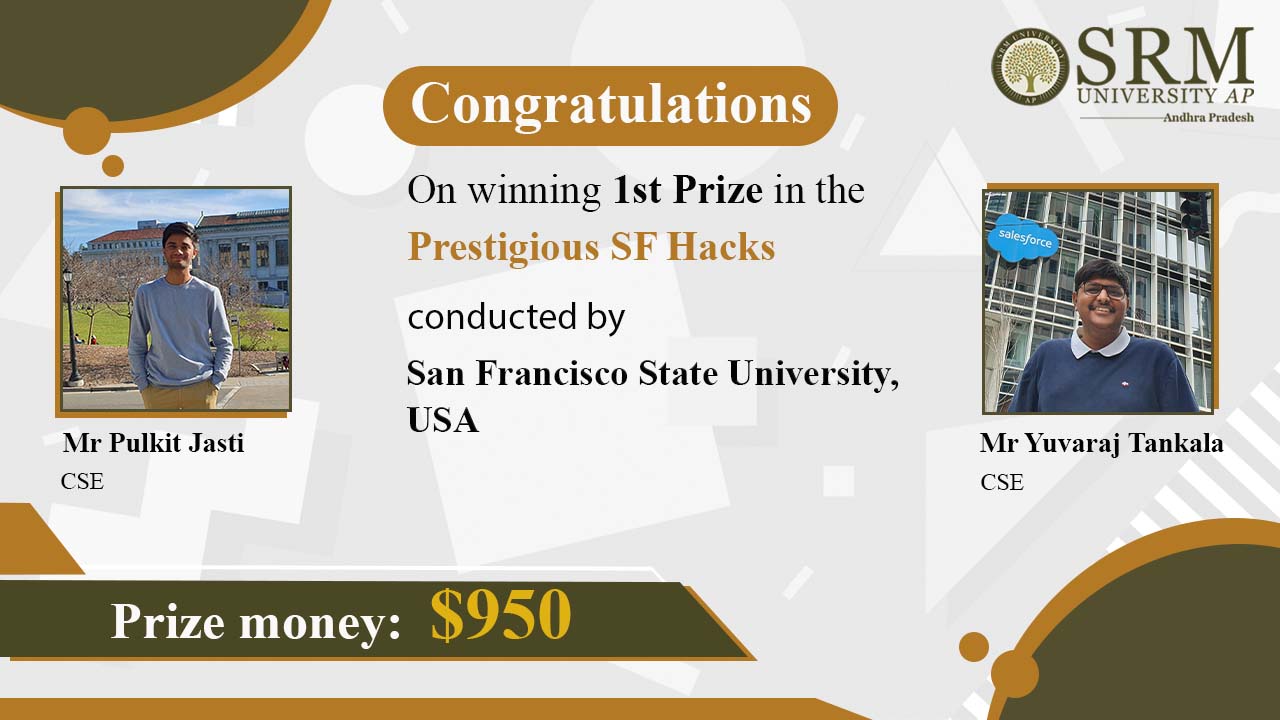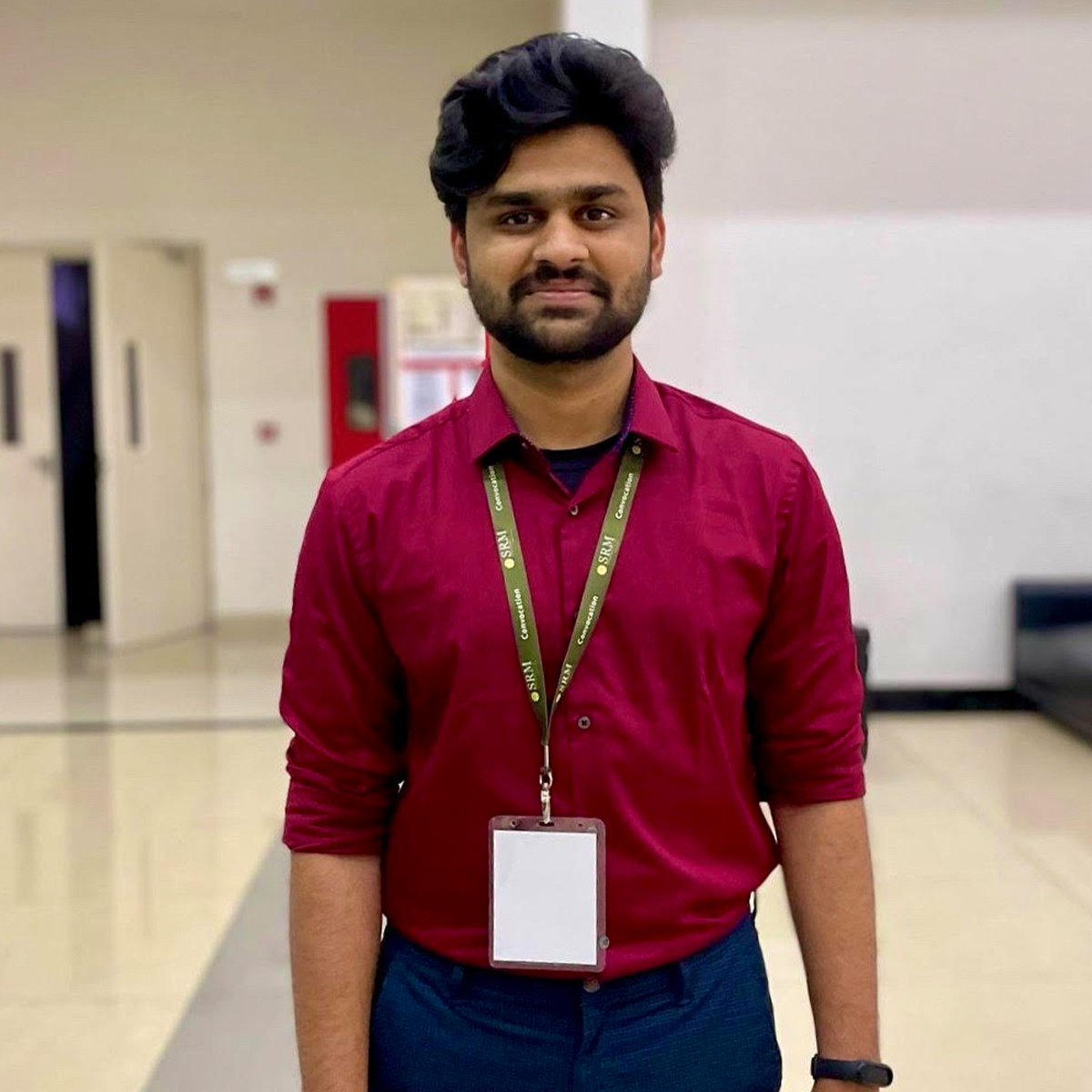Smart COVID-shield: An IoT driven reliable and automated prototype for Covid-19 symptoms tracking
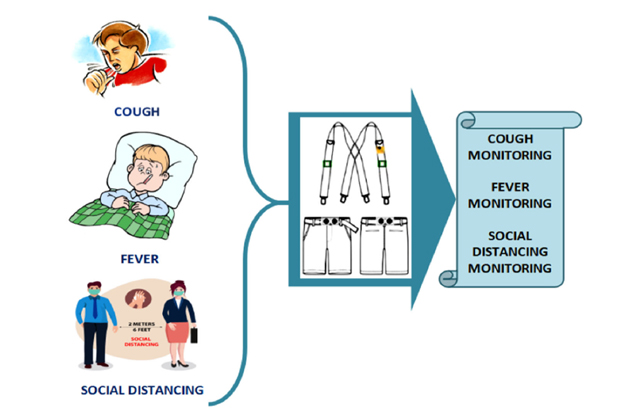 Persistent dry coughing and abnormally high body temperature are identified as more relevant risk factors associated with the COVID-19 crisis. Besides these, maintaining 6 feet social distancing norm was also recognized as a crucial factor. By taking these three features into consideration, the research group consisting of Dr Kshirasagar Sahoo, Assistant Professor, Department of Computer Science and Engineering at SRM University-AP have designed a smart, reliable and efficient COVID-19 tracking device model to monitor suspected infected people in public places. The device named “Smart COVID-Shield” utilising the IoT technology is equipped with a suspender and a belt to be placed over the clothes of the user which constitutes a cough detect unit, temperature detects unit and distance computing unit. Coughing and temperature patterns can be detected through the PIR sensor of the suspender while a belt with an ultrasonic sensor can be used to track people who violate the 6 feet social distancing norms in a real-time environment. A research paper titled “Smart COVID-shield: An IoT Driven Reliable and Automated Prototype for COVID-19 Symptoms Tracking” is published in Computing Journal as a part of the project.
Persistent dry coughing and abnormally high body temperature are identified as more relevant risk factors associated with the COVID-19 crisis. Besides these, maintaining 6 feet social distancing norm was also recognized as a crucial factor. By taking these three features into consideration, the research group consisting of Dr Kshirasagar Sahoo, Assistant Professor, Department of Computer Science and Engineering at SRM University-AP have designed a smart, reliable and efficient COVID-19 tracking device model to monitor suspected infected people in public places. The device named “Smart COVID-Shield” utilising the IoT technology is equipped with a suspender and a belt to be placed over the clothes of the user which constitutes a cough detect unit, temperature detects unit and distance computing unit. Coughing and temperature patterns can be detected through the PIR sensor of the suspender while a belt with an ultrasonic sensor can be used to track people who violate the 6 feet social distancing norms in a real-time environment. A research paper titled “Smart COVID-shield: An IoT Driven Reliable and Automated Prototype for COVID-19 Symptoms Tracking” is published in Computing Journal as a part of the project.
Abstract of the paper:
IoT technology is revolutionizing healthcare and is transforming it into more personalized healthcare. In the context of the COVID-19 pandemic, IoT’s intervention can help to detect its spread. This research proposes an effective “Smart COVID-Shield” that is capable of automatically detecting prevalent symptoms like fever and coughing along with ensuring social distancing norms are properly followed. It comprises three modules which include Cough Detect Module (CDM) for dry cough detection, Temperature Detect module (TDM) for high-temperature monitoring, and Distance Compute Module (DCM) to track social distancing norm violator. The device comprises a combination of a lightweight fabric suspender worn around the shoulders and a flexible belt wrapped around the waist. The suspender is equipped with a passive infrared (PIR) sensor and temperature sensor to monitor persistent coughing patterns and high body temperature and the ultra-sonic sensor verify 6 feet distance for tracking an individual’s social distancing norms. The developed model is implemented in an aluminium factory to verify its effectiveness. Results obtained were promising and reliable when compared to conventional manual procedures. The model accurately reported when body temperature rises. It outperformed thermal gun as it accurately recorded a mean of only 4.65 candidates with higher body temperature as compared to 8.59% with the thermal gun. A significant reduction of 3.61% on social distance violators was observed. Besides this, the latency delay of 10.32 s was manageable with a participant count of over 800 which makes it scalable.
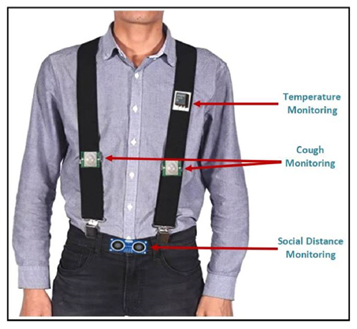
This is a collaborative work of H. K. Tripathy, S. Mishra from School of Computer Engineering, KIIT Deemed to Be University, Bhubaneswar, Odisha, India and A. Nayyar from Graduate School, Faculty of Information Technology, Duy Tan University, Da Nang 550000, Vietnam.
Early detection of the coronavirus symptoms is one feasible means to restrict the spreading of coronavirus. The IoT enabled “Smart COVID-Shield” is developed and implemented in this study to monitor social distancing violators in crowded places. In future, all other COVID symptoms can be incorporated into the model to make it more effective and real-time. An emergency alert module can also be included as part of the model to create awareness among people. An enhanced security mechanism can be further embedded in the working model to prevent any data compromise and dilution in data availability.
- Published in CSE NEWS, News, Research News
Advanced research on secure transmission of medical images
 SRM University-AP promotes translational research that can add value to society making lives better. Following the tradition, Dr Priyanka Singh, Assistant Professor and her PhD student Ms Jyothsna Devi from the Department of Computer Science and Engineering have published their recent research work “Region-based Hybrid Medical Image Watermarking Scheme for Robust and Secured Transmission in IoMT” in ‘IEEE Access journal’ (Impact Factor of 3.36).
SRM University-AP promotes translational research that can add value to society making lives better. Following the tradition, Dr Priyanka Singh, Assistant Professor and her PhD student Ms Jyothsna Devi from the Department of Computer Science and Engineering have published their recent research work “Region-based Hybrid Medical Image Watermarking Scheme for Robust and Secured Transmission in IoMT” in ‘IEEE Access journal’ (Impact Factor of 3.36).
Dr Priyanka’s research focuses on the healthcare industry that is rapidly transforming medical images into ones that operate in real-time environments (IoMT, IoT, Cloud and so on). The research is proposed to address security and integrity issues in medical image transmission on IoT and edge healthcare applications with a lossless reversible region-based MIW scheme.
In this era of technological advancement, medical images and patient information are widely transmitted through a public transmission channel on the Internet of Medical Things (IoMT) applications. While sharing medical images or electronic patient records (EPR) through a public network, they can get tampered with or manipulated, leading to the wrong diagnosis by the medical consultants. Confidentiality of the patient record is also a major concern. Thus, it is very important to ensure the authenticity, authorisation, integrity, and confidentiality of the information during transmission.
ABSTRACT:
With the growth in Internet and digital technology, the Internet of Medical Things (IoMT) and Telemedicine have become buzzwords in healthcare. A large number of medical images and information are shared through a public network in these applications. This paper proposes a region-based hybrid Medical Image Watermarking (MIW) scheme to ensure the authenticity, authorisation, integrity, and confidentiality of the medical images transmitted through a public network in IoMT. In the proposed scheme, the medical image is segmented into Region of Interest (RoI) and Region of Non-Interest (RoNI).
RoI tamper detection and recovery bits are embedded in RoI to ensure the integrity of the medical image. RoI is watermarked using adaptive Least Significant Bit (LSB) substitution with respect to the hiding capacity map for higher RoI imperceptibility and accuracy in tamper detection and recovery. Electronic Patient Record (EPR) is compressed using Huffman coding and encrypted using a pseudo-random key (secret key) to provide higher confidentiality and payload. Encrypted EPR, QR code of hospital logo and RoI recovery bits are embedded in RoNI using Discrete Wavelet Transform-Singular Value Decomposition (DWT-SVD) hybrid transforms to achieve a robust watermark.
The proposed scheme is tested under various geometric and non-geometric attacks such as filtering, compression, rotation, salt and pepper noise and shearing. The evaluation results demonstrate that the proposed scheme has high imperceptibility, robustness, security, payload, tamper detection, and recovery accuracy under image processing attacks. Therefore, the proposed scheme can be used in the transmission of medical images and EPR in IoMT. The relevance of the proposed scheme is established by its superior performance in comparison to some of the popular existing schemes.
- Published in Computer Science News, CSE NEWS, News, Research News
Vision-based fall detection AI
Human-like care is difficult to replicate. Due to the lack of a reliable vision-based fall detection AI, it is often more effective to assign a lot of manpower towards vision-based detections that have not been efficiently implemented.
Ms Inturi Anita Rani, Research Scholar in the Department of Computer Science Engineering, working with her supervisor, Dr V. M. Manikandan, has worked on a paper titled, “A Novel Vision-Based Fall Detection Scheme using Keypoints of Human-Skeleton with Long Short-term Memory Network” in the Arabian Journal for Science and Engineering published by Springer with an Impact Factor of 2.33.
Abstract of the research:
Humans are skilled at visually recognizing and classifying actions in videos, but it’s tough to automate this process. Human action detection in videos is useful in applications like automated surveillance, assisted living, human-computer interaction, content-based video retrieval, and video summarization. The ability to recognize atomic actions like “walking,” “bending,” and “falling” is critical for activity analysis when monitoring elderly people’s daily activities. Our paper presents a new promising solution for fall detection using vision-based approaches. In this approach, we analyse the human joint points which are the prime motion indicators. A set of keypoints of the subject are acquired by applying the AlphaPose pre-trained network. These keypoints are inferred to be the joint points of the subject. The acquired keypoints are processed through a framework of convolutional neural network (CNN) layers. Here, the spatial correlation of the keypoints is analysed. The long-term dependencies are then preserved with the help of long short-term memory (LSTM) architecture. Our system detects five types of falls and six types of daily living activities. We used the UP-FALL detection dataset for validating our fall detection system and achieved commendable results when compared to the state-of-the-art approaches. For comparison, we employed the OpenPose network for keypoint detection. It is inferred from the results that the AlphaPose network is more precise in keypoint detection.
About the research paper:
In this paper, the author proposes a vision-based system that is capable of detecting various types of falls accurately through video processing with the help of a machine learning approach.
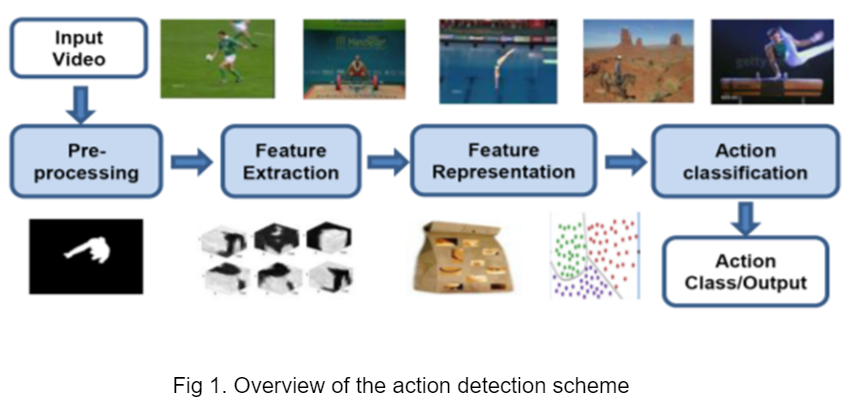
Implementation of the research:
The proposed scheme can be used to monitor the activity of elderly people and if any unusual falls happen, the information can be shared with caretakers to ensure emergency services.
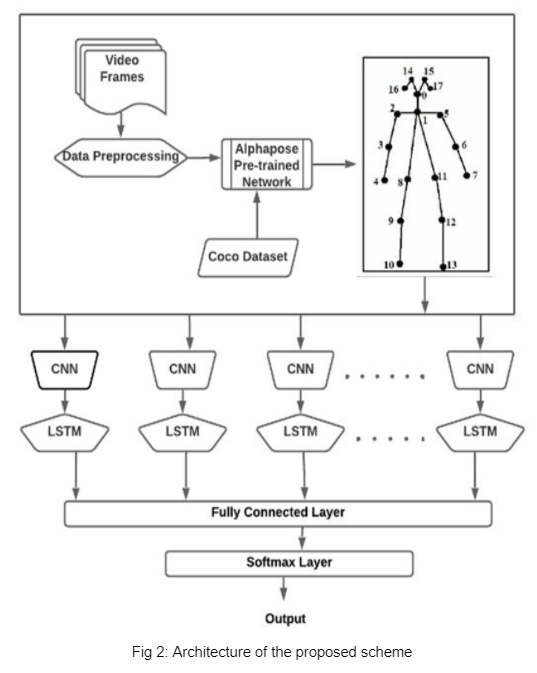
- Published in CSE NEWS, Departmental News, News, Research News
Security Framework using Blockchain Technology
The Department of Computer Science Engineering is proud to announce that Dr Sriramulu Bojjagani has published a paper titled “Blockchain-Based Security Framework for Sharing Digital Images using Reversible Data Hiding and Encryption” in the journal Multimedia Tools and Applications (MTAP) having an impact factor of 2.757.
The paper is published in collaboration with D.R Denslin Brabin from the Department of Computer Science and Engineering, DMI College of Engineering, Tamil Nadu and Christo Ananth from the Department of Electronics and Communication Engineering, St. Mother Theresa Engineering College, Tamil Nadu.
Abstract of the Research
Security is an important issue in current and next-generation networks. Blockchain will be an appropriate technology for securely sharing information in next-generation networks. Digital images are the prime medium attacked by cyber attackers. In this paper, a blockchain-based security framework is proposed for sharing digital images in a multi-user environment. The proposed framework uses reversible data hiding and encryption as component techniques. A novel high-capacity reversible data hiding scheme is also proposed to protect digital images. Reversible data hiding in combination with encryption protects the confidentiality, integrity and authentication of digital images. In the proposed technique, the digital image is compressed first to create room for data hiding, then the user signature is embedded; afterwards, the whole image is encrypted. For compression, JPEG lossy compression is used to create high capacity. For encryption, any symmetric block cipher or stream cipher can be used. Experimental results show that the proposed blockchain-based framework provides high security and the proposed reversible data hiding scheme provides high capacity and image quality.

Fig 1: The process of encoding during reversible data hiding
Dr Sriramulu Bojjagani also intends to work on the development of block-chain based solutions to intelligent transport systems and on addressing the challenges of security issues involved in connected and autonomous vehicles.
- Published in CSE NEWS, Departmental News, News, Research News
Introducing decentralized security system using blockchain technology
The Department of Computer Science and Engineering is delighted to announce that Dr Rajiv Senapati and his research group; Abhiram Chakravadhanula, Jaswanth Kolisetty, Karthik Samudrala and Bharat Preetham have published a research article titled “A Novel Decentralized Security Architecture for the Centralized Storage System in Hadoop using Blockchain Technology” in the Scopus indexed IEEE 7th I2CT (The premier conference for the latest discoveries in Convergence in Technology in Asia Pacific).
Over the past decades, the Big Data ecosystem is experiencing a humungous explosion in the generation and exchange of information. Trading such delicate information can serve as a profitable knowledge resource in the present economy. However, serious concerns have been raised about the security and assurance of delicate data as the conventional safety architecture in centralized storage systems does not meet its nuanced requirements. Blockchain technology offers a promising solution for big data protection due to its decentralized nature. Through this research article, Dr Rajiv Senapati and his students intend to introduce a decentralized security architecture in centralized storage systems such as Hadoop to address its existing vulnerabilities.
Abstract of the Research
Big Data is huge in volume, diverse in information, and growing at flourishing rates. The major distributed file systems in the current market in Big Data Analysis include Apache Hadoop, Storm, Cassandra, Flink, Cloudera, and many more. Hadoop is an open-source framework divided into Hadoop Distributed File System (HDFS) and Map-Reduce. Hadoop plays a leading role in storing and processing Big Data in contemporary society as it is cost-effective and can manage large volumes of data in low-cost commodity hardware. HDFS is a type of Data Warehouse which is scalable and has fast access to information.
Metadata is the information about the data, such as which block is storing on what datanode, how many replications that block has, and on which datanodes those replications reside. In HDFS, this metadata is stored at a fixed place in namenode, and attackers can access the metadata and modify it without notice. Also, metadata is mutable, which means the attacker can erase his presence easily.
In this paper, to resolve this issue, we have provided a mechanism using blockchain technology that follows a decentralized architecture against the centralized architecture followed by HDFS. Hyperledger Fabric (HLF) is the blockchain proposed to be effective and trusted for such a purpose. HLF is a private blockchain with a distributed immutable ledger. The metadata will be stored in the ledger. If an attacker tries to modify the data, he cannot erase his presence as the ledger is immutable, unlike HDFS. Further, the work proposed in this paper can be extended in real-time HDFS with a secure ledger and multiple nodes.
- Published in CSE NEWS, Departmental News, News, Research News
Sikindhar Jaladi represents Andhra Pradesh in National Youth Parliament Festival 2022
The youngest National level participant of the year
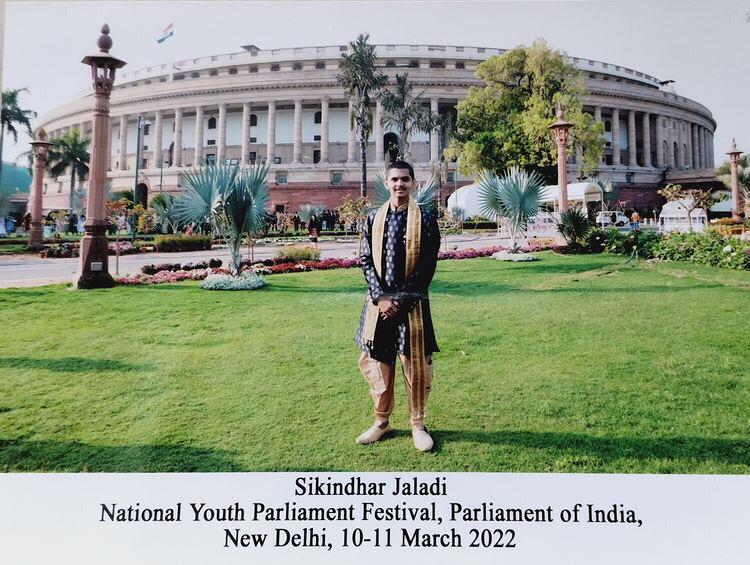 The national youth parliament initiative intends to strengthen the roots of democracy among India’s youth population. Sikindhar Jaladi, a first-year BTech Computer Science student at SRM University-AP, won district and state level elocution competitions and participated in the National Youth Parliament Festival 2022 conducted by the Ministry of Youth Affairs and Sports, Government of India.
The national youth parliament initiative intends to strengthen the roots of democracy among India’s youth population. Sikindhar Jaladi, a first-year BTech Computer Science student at SRM University-AP, won district and state level elocution competitions and participated in the National Youth Parliament Festival 2022 conducted by the Ministry of Youth Affairs and Sports, Government of India.
Mr Sikindhar bagged first place in the district level elocution competition in the District Youth Parliament in Krishna District on February 19, 2022, wherein he talked on the topic of Digital India. The top 2 participants from all districts of Andhra Pradesh competed at the state level, and Mr Sikindhar proved his mettle again, securing first place in elocution on the topic Startup India, Standup India.
Across India, approximately 2,40,000 ( two lac forty thousand) people have competed on all levels. In that, only 87 (3 from each state, 29*3=87) of them were shortlisted to attend the national level. Out of which only 29 (1st place winners from each state) of them availed a chance to speak at the Parliament. Being the 1st place winner from Andhra Pradesh, Mr Sikindhar represented the state and delivered his speech in the Parliament House (Sansad Bhavan) in front of the Honourable Speaker, Cabinet Ministers of the central Government, Entrepreneurs and other Dignitaries.
National Youth Parliament Festival (NYPF) is a national level competition organised by the Union Ministry of Youth Affairs and Sports in partnership with the Nehru Yuva Kendra Sangathan since 2019. (NYKS).
Read this exclusive interview with Mr Sikindhar on his journey to Indian Parliament House
“I am delighted to have got the opportunity to speak at Parliament, which is the highest forum of discussion and debate on public issues and national policy”, says Mr Sikindhar. “Also, I was the youngest youth parliamentarian aged 18 among all the participants”, he added joyfully.
Preparation for the State Level Elocution Competition
The topics were released one day before the state-level competition. Having a dream to become an entrepreneur, I chose Start-up India-Stand-up India among the given topics. I know how the start-up ecosystem has been growing in India and the sectors in which the Indian start-ups are emerging. On an important note, I would like to thank SRM University-AP for providing an entrepreneurship cell( Ecell) that solely focuses on starting up and inculcates leadership and entrepreneurial qualities in young minds. I would also thank our director of entrepreneurship cell Udayan Bakshi sir. I’m a member of the SRM Ecell at the Industree Owl, which helped me get acquainted with some startup and business terminologies.
Experience at SRM AP
Being a fresher, I like the experience here at SRM AP. I have good friends from all over the country. Those from the North Indian states like Haryana, Uttar Pradesh, West Bengal and Bihar help me gradually learn Hindi. And that knowledge of Hindi helped me highlight some points of my speech in Hindi, which made my address more attractive. Suman Kumar from Bihar, my classmate and CSE project partner at SRM AP, helped in preparing my speech. Hopefully, I will enjoy and experience the fullest from the university once the university reopens for onsite classes.
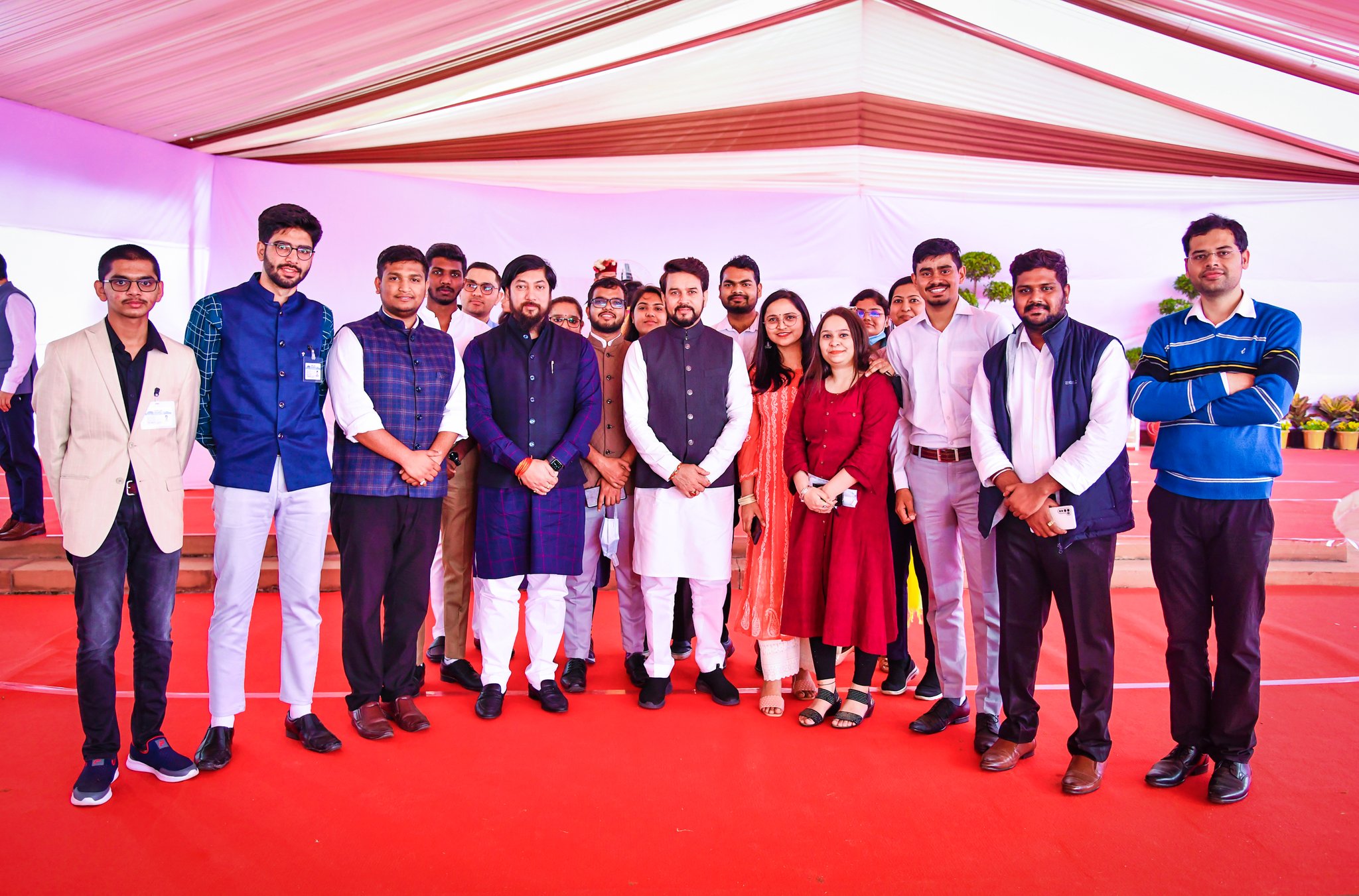
About the National Level Elocution competition in Delhi
The experience at the national level competition was truly unique. Best speakers from all the states were competing there. Though I was a bit anxious, I’m happy that I learned many things. Among all the speakers and participants, I was the youngest one. I loved the whole trip and made a lot of connections and friends. I met Shri Om Birla– Hon’ble Speaker of Lok Sabha, Shri Anurag Singh Thakur– Hon’ble Minister of Youth Affairs and Sports, Shri Nisith Pramanik– Hon’ble Minister of State, Youth Affairs & Sports. We had a beautiful conversation with the honourable union ministers Anurag Singh Thakur and Nisith Pramanik about the problems faced by the people of India, responsibilities and fundamental duties of the youth and the people of India in policymaking. I would also like to share that I had a chance to have dinner with the honourable Union Minister Shri Nisith Pramanik on March 10th evening. We also experienced a beautiful cultural event with the union ministers and members of Parliament (MPs).
Support received from SRM AP
Definitely, SRM AP played a crucial role in the journey. When the state level results were announced, our beloved Vice Chancellor sir, Pro-Vice-chancellor sir, Dean SEAS Prof B V Babu sir, Student Affairs Assistant-Director Revathi ma’am, ITKM Associate Director Arundhati ma’am, ITKM department, management, faculty members, and friends encouraged and motivated me. As I mentioned earlier, I would like to thank SRM University for providing an entrepreneurship cell (Ecell) that solely focuses on starting up and teaches leadership and entrepreneurial qualities in young minds. I’m a member of the SRM Ecell at the Industree Owl department, which helped me get acquainted with some startup and business terminologies.
- Published in CSE NEWS, Departmental News, News
Machine learning algorithms predict stock market trends
Understanding stock market trends is crucial for investors to make key decisions. It was indeed a wonderful moment when Katla Sai Naveen from the Department of Computer Science and Engineering, presented a paper for the first time with an intelligent solution to that problem. The paper “A Novel Stock Price Prediction Scheme from Twitter Data by using Weighted Sentiment Analysis” was presented at the 12th International Conference on Cloud Computing, Data Science & Engineering (CONFLUENCE-2022), organised by Amity University, Noida, UP, India. It was co-authored by Nikhila Korivi, Godavarthi Chandra Keerthi under the mentorship of Dr V M Manikandan, Assistant Professor, Computer Science and Engineering. The paper will later be published in IEEE Xplore Digital Library.
Abstract:
Stock market forecasting is one of the most interesting research areas for many professionals and researchers. Economic conditions, investor sentiment, current events, future guidance, and a variety of other factors have an impact on the stock market. Since the stock market changes swiftly from time to time, it might be tough for a user or investor to keep up with the shifting trend. Combining sentiment analysis with a machine learning model, a solution to this problem has been introduced. Sentiment analysis is a text mining procedure that has one of the most important uses in analysing user reviews and evaluating the overall sentiment of a piece of text. The purpose of this research work is to create a machine learning model that takes recent tweets from the Twitter API and categorises each message as positive, bad, or neutral. Later, the impact of the person who wrote the tweet is also considered while predicting the trend. The parameters such as the total number of followers, the emotion of each comment on each post of selected stock, the number of likes and retweets are considered. An overview of the selected stock’s potential will be given to the user as the output.
This research will be useful for businessmen and people with enthusiasm for the stock market. The research will provide insights and intelligence to help make profitable decisions. False positives during sentiment analysis is a major concern in this domain. The team is focused on improving the existing approaches with better methods to identify false positives.
- Published in CSE NEWS, News, Research News, Students Achievements
Students pursuing semester abroad topped SF Hacks
SRM University-AP is indeed proud of its young and intelligent minds who continue to bring honour and glory to the institution from across the globe. Pulkit Jasti and Tankala Yuvaraj, two of our students from the Department of Computer Science Engineering currently pursuing Semester Abroad Programme at the University of California, Berkeley have won first prize in the prestigious SF Hacks conducted by San Francisco State University, USA, and bagged a total of $950 ($600 for 1st Prize, $250 for Best UI/UX Design, and $100 for Best AIML Hack).
The world has always been ruled and sustained by ideas. Innovating and executing the unthinkable are what helped us tide over the unprecedented hardships the pandemic entailed. SF Hacks 2022, San Francisco’s largest collegiate hackathon was conceived to hatch some striking ideas under the tracks: inclusivity, mental health, sustainability, and machine learning to put the latest technologies to use in the fittest way possible to render solutions to the unending maladies of corona and climate change.
Pulkit Jasti and Tankala Yuvaraj have tread out of the way to introduce an AI-based classroom system that monitors the mental-well being of the students. It is an unfortunate fact that our classrooms have often overlooked the emotional and mental well-being of the students. The transition to virtual mode has made the scenario even worse. Researches state that the depression rates in students between ages 10-18 have increased by 72% since the pandemic.
According to Pulkit and Yuvaraj, this incredible innovation monitors various parameters like facial expressions, voice, attentiveness of a student during the class and generates a meta score that gives an overall idea about the mental well-being of the student. Based on this score, the school counsellors will be notified and then the student can have a one on one therapy session with the counsellor. This system can help identify signs of depression at early stages which makes classroom a safe learning environment for students.
They were determined to come up with an effective solution to redefine the conventional classroom setup and make learning a wholesome experience. “After selecting a problem and drafting the base of the project, we were assured that it could create a positive impact for students during these unprecedented times of the Covid-19 outbreak”, they said.
“During the hackathon, we ran into a lot of technical issues and roadblocks but were able to overcome them and submit our final prototype. To be a part of such a huge event where there were around 1000+ participants from over 26 countries was indeed a remarkable learning experience”, they expressed their feeling of contentment. “We can never thank enough our faculty at SRM for their enormous support throughout our journey at the University of California Berkeley” they added.
- Published in CSE NEWS, Departmental News, News, Students Achievements
Paper presentation in International Conference on Innovations in Information Technology
Mr Mudigonda Himansh, a 3rd-year BTech-CSE student, has presented a research paper in the IEEE International Conference on Innovations in Information Technology-2022 organised by IIIT Kottayam, Kerala India, in Feb-2022. The paper will be published in IEEE Xplore (Scopus indexed). Dr V M Manikandan, Assistant Professor in Computer Science and Engineering at SRM University-AP, is the co-author of the presented paper titled “A Statistical Study and Analysis to Identify the Importance of Open-source Software”.
Open-source software has picked up pace in the past decade with support from multinational conglomerates and huge open-source communities. We hear a lot about the success of many open-source projects, but we fail to understand how many do not make it. In this paper, Mr Himansh and Dr Manikandan understand the dynamics behind open-source software. They start with the need for open-source alternatives. Then look at a few concerns open-source software developers and maintainers face. Next, we would understand the various requirements of open-source software. Later, we would touch upon the different attributes that affect the selection of open-source software and the decisions to make while building general-purpose, open-source software. Then we would analyse the 5-determinants of open-source software success. Finally, we would look at the data collected from 482 data points from 24 countries and then analyse the data by forming graphs and charts.
This research provides the required knowledge to the open-source and non-open source software developers before-during-after development and production of the software or project. “Our future work is focused on the applications and predicting the scalability of large-scale OSS with machine learning,” says Dr Manikandan.
- Published in CSE NEWS, Departmental News, News, Research News
CSE students bagged 2nd prize at I-Wallet design competition organised by IIT Bombay
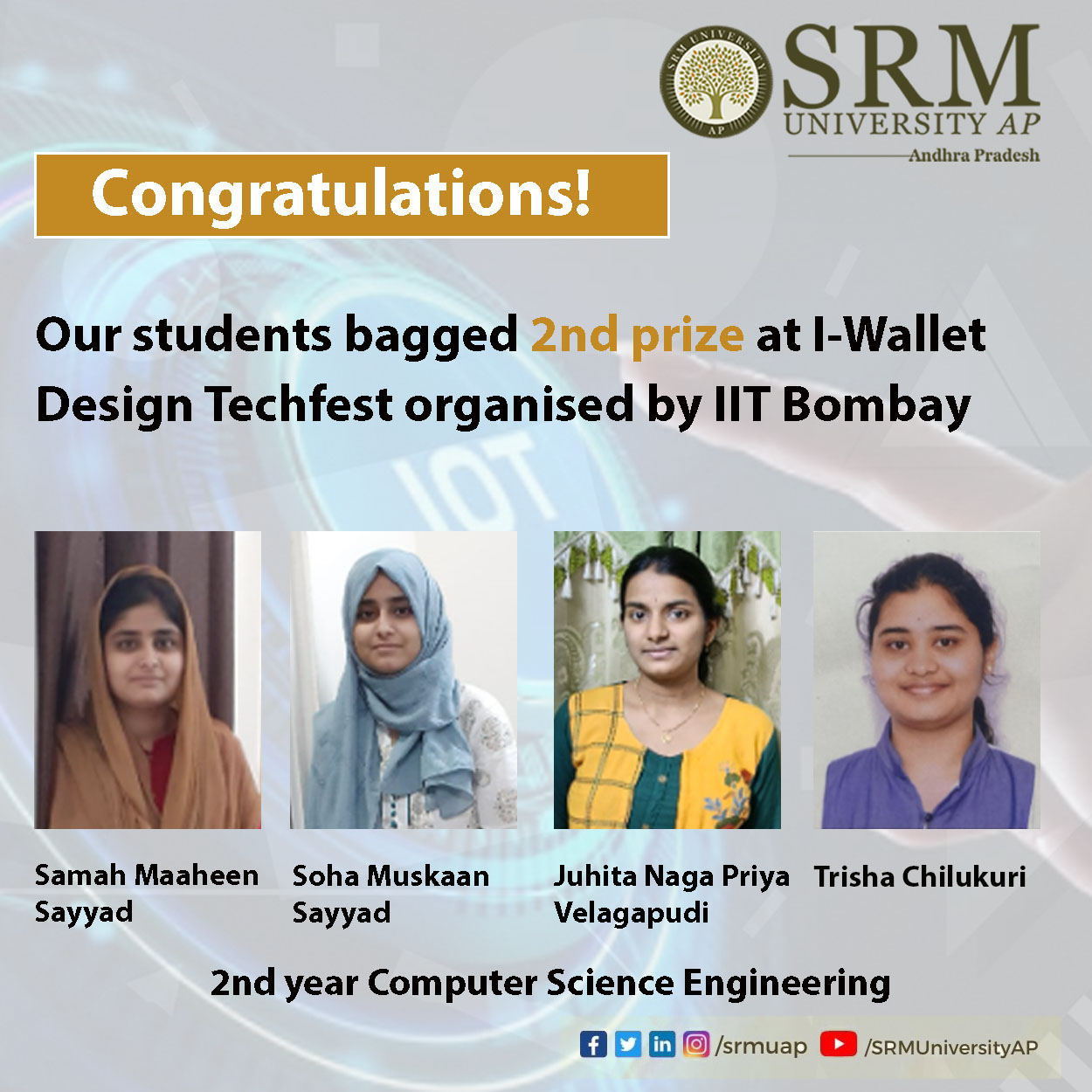 Soha Muskaan Sayyad, Samah Maaheen Sayyad, Juhita Naga Priya Velagapudi, and Trisha Chilukuri from 2nd-year Computer Science Engineering have achieved 2nd place in the I-Wallet Design Techfest, organised by IIT Bombay. Dr Sonam Maurya, Assistant Professor, Department of Computer Science and Engineering, guided the students to achieve this incredible feat.
Soha Muskaan Sayyad, Samah Maaheen Sayyad, Juhita Naga Priya Velagapudi, and Trisha Chilukuri from 2nd-year Computer Science Engineering have achieved 2nd place in the I-Wallet Design Techfest, organised by IIT Bombay. Dr Sonam Maurya, Assistant Professor, Department of Computer Science and Engineering, guided the students to achieve this incredible feat.
The students started their work in December and explored a lot about IoT while working on it. More than 100 teams participated in this competition. In January, ten teams got selected for the second round, i.e., Report Submission, and our students were one of them. In February, based on the reports submitted, six teams, including our students, were selected for the final round, i.e., to present the proposed idea to the judges’ panel. Finally, the students bagged second place in the competition with cumulative prize money of INR 90,000.
Regarding the I-Wallet, students say that “Smart Wallet is an easy-to-use wallet that is designed for providing secured transactions”. It has minimal energy consumption, more security, and a few advanced features, some of which are not included in the regularly used wallets. The advanced IoT features enable it to be kept in our pockets with smartphones and smartwatches. The design received recognition from the expert panel members based on these features.
The team has also initiated the process to file a patent on the design of wallet. Students expressed their gratitude to Dr Sonam Maurya, Assistant Professor, Computer Science and Engineering, for her relentless guidance and continuous support towards the project. They also thanked SRM University-AP for providing the opportunity to participate in this national level competition organised by IIT Bombay.
Prof B V Babu, Dean, School of Engineering and Sciences, appreciated the students and their faculty mentors. “Keep up the good work, continue to excel in all your future endeavours at professional and personal levels and bring laurels to your alma mater”, he said in the congratulatory message.
- Published in CSE NEWS, Departmental News, News, Students Achievements


